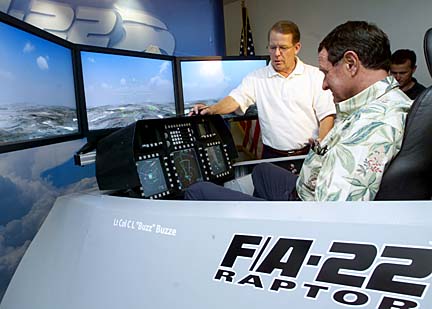
|
Fighter pilots
preview silent killer
A simulator shows off the "quantum
leap" of the Raptor stealth jet
|
When Allan Palmer took off on an F-4 Phantom bombing mission over North Vietnam four decades ago, the enemy knew exactly where he was and when he was about to strike, Palmer says.
That would never happen with the F/A-22 Raptor, which will eventually replace the current Air Force squadrons of F-15 Eagle jet fighters, said Palmer, who flew combat jets in the Air Force and Navy for 20 years.
Aerial combat has taken "quite a quantum leap" with the Raptor stealth jet fighter, said Palmer, now chief executive officer for Ford Island's Pacific Aviation Museum.
Palmer had just finished a session in the seat of a $2 million cockpit demonstrator that Lockheed Martin brought to the islands to give Pacific Command staff and other military and civilian leaders a feel of what it's like to fly one of the Air Force's latest weapons.
Rob Fuller, Lockheed Martin Raptor spokesman, described the jet as "a first look, first shot, first kill" fighter.
With stealth technology, "you don't have to get close, and the days of the close dogfights are gone," Palmer explained.
A Raptor pilot as far as 40 miles from his target and traveling at 1.5 times the speed of sound can lock on to an enemy fighter and take it out with a missile before the other aircraft realizes he has been targeted.
The design reduces the size of the Raptor on enemy radar to the size of a bumblebee, in effect making it undetectable. Its angular design helps to nearly eliminate detection of its sound, heat or turbulence.
Fuller said the stealth fighter also has supercruise, which allows the jet to fly at supersonic speed without afterburners, conserving fuel.
Its stealth design means that there are no rocket pods or bombs hanging from the wings, Fuller added.
The simulator uses three large video screens and replicates the hand controls of the jet fighter.
But with a price tag of $130 million for each F/A-22, it is the nation's most expensive aircraft program, surpassing the Navy's McDonnell Douglas F/A-18 Super Hornet jets.
Lockheed has the contract to build 83 Raptors at its Marietta, Ga., facility, Fuller said, with 55 built and 43 already delivered. The Air Force has said it hopes to have 381 Raptors eventually, with each of its 10 wings getting 24.
But the Pentagon wants to cut $10 billion out of the Air Force's $70 billion Raptor program, which could reduce the number of Raptors in the Air Force arsenal.
Fuller said the first Raptor squadron will be operational at the end of the year at Langley Air Force Base in Virginia. The Virginia Air Force squadron will include Air Guard pilots trained to fly the Raptor.
Air Force officials here don't know when the F-15 Eagles assigned to the Hawaii Air National Guard would be replaced by the Raptors.
Lt. Col. Steve Clutter, Pacific forces spokesman, said that although none of the Raptors will be based at Hickam Air Force Base, Elmendorf Air Force Base in Alaska, part of the Pacific Air Forces, will get two squadrons within the next five years.
Last week, the Air Force said a flight-control system malfunction caused the first crash of a Raptor on Dec. 20 on the runway at Nellis Air Force Base, north of Las Vegas . A power interruption left the pilot unable to fly the Raptor, and he ejected, receiving only minor injuries. The aircraft, one of eight assigned to Nellis' 422nd Test and Evaluation Squadron, was destroyed.
E-mail to City Desk
[News] [Business] [Features] [Sports] [Editorial] [Do It Electric!]
[Classified Ads] [Search] [Subscribe] [Info] [Letter to Editor]
[Feedback]
